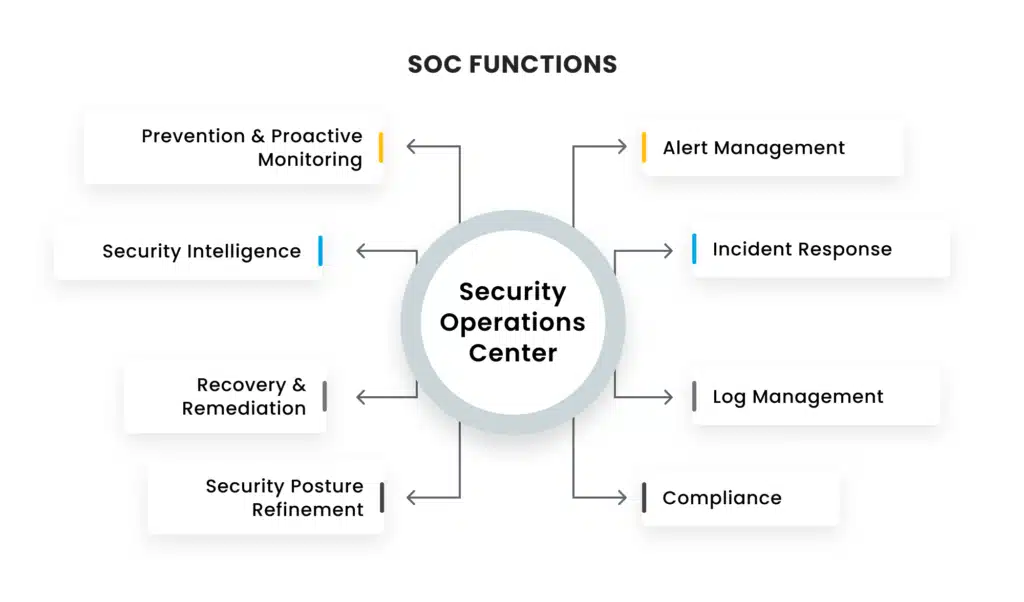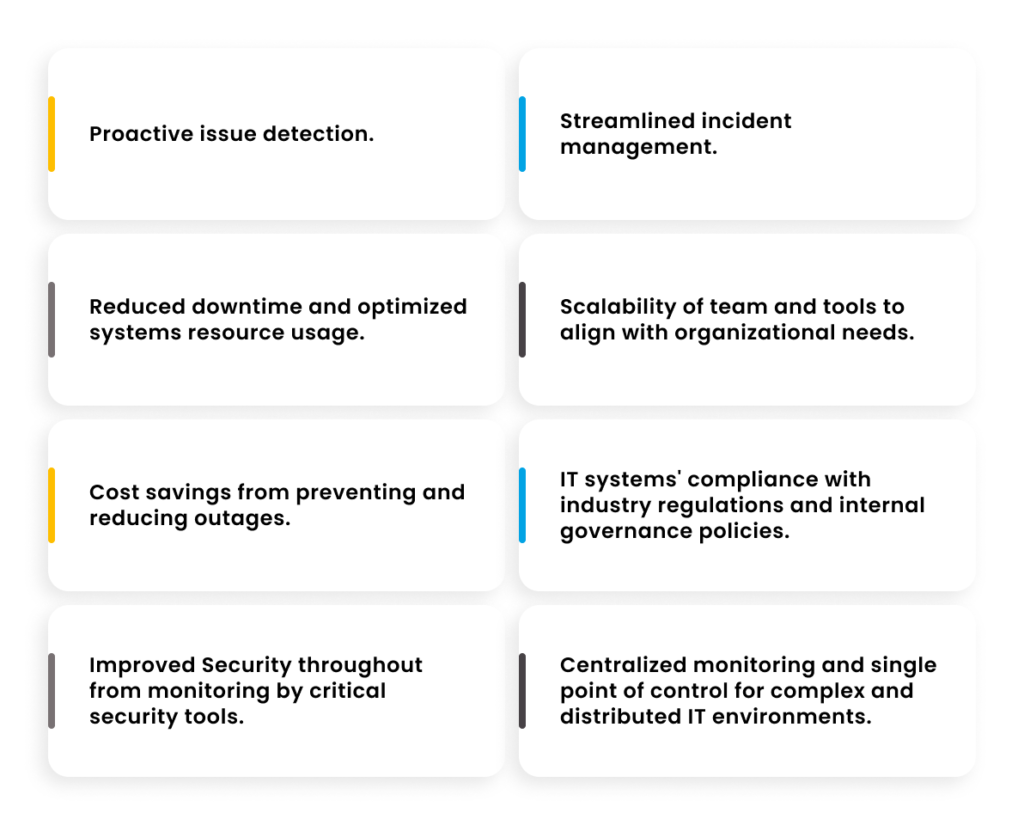In brief:
- Network outages and data breaches can have devastating short and long-term effects on companies, irrespective of their size and industry.
- The increasing use of cloud technologies, software-defined architectures, and hybrid, distributed architectures make having an IT Operations Center indispensable.
- For organizations struggling with cost, organizational complexity, and other factors, outsourcing IT network management to a reliable, trusted managed services provider (MSP) can be the best solution.
Picture a U.S.-based consumer electronics company with thousands of employees, global operations, and a sprawling digital infrastructure. While the company sells cutting-edge technology products, for their own IT infrastructure, they continue using their decades-old processes and decentralized method for managing their IT network
One day, a major customer’s confidential data was leaked online. When it was detected and traced by the company, it took them weeks to realize that hackers had exploited an unnoticed vulnerability in one of their South Asia offices. Not only did they lose that customer, they also ended up facing regulatory penalties and lawsuits, while also suffering a significant drop in customer retention and revenue.
Here’s another one: a major retailer with a vast offline and online presence. They manage a complex network infrastructure that connects thousands of physical stores and an extensive online platform but are reluctant to establish an IT Operations Center, citing cost and complexity of management.
During the peak holiday shopping season, a network outage brought transactions at both physical stores and the online platform to a standstill. The outage also impacted access to the inventory database, resulting in store employees being unable to serve customers or process online orders. With the entire sales operation at a standstill, the retailer ended up losing tens of thousands of dollars per minute in revenue.
The above scenarios are not completely imaginary. From airlines to retailers to some of the biggest technology companies, several major organizations have made news in recent years as they were hit by crippling network outages and data breaches, which not only led to significant losses of revenue and stock value but also hurt customer confidence and reversed years of image building.
One in six organizations in the past three years reported an outage involving significant financial losses, reputational damage, compliance breaches and, in some severe cases, loss of life, Uptime Institute’s 2023 Outage Analysis found. More than two-thirds of all outages resulted in losses of more than $100,000.
Nearshore vs. Offshore: Navigating the Hidden Hassles of Outsourcing to Asia

Data breaches are even costlier. The average cost of a data breach touched a record high of $4.35 million in 2022, IBM’s Cost of a Data Breach Report found, with 83% of organizations surveyed saying they had experienced more than one breach.
The COVID-induced rush to adopt cloud technologies – to aid business continuity and remote working – along with the growing presence of software-defined networks and hybrid, distributed architectures have resulted in complex IT landscapes, distributed assets, dynamic resource scaling, and heightened security concerns. All of these have made it necessary to have an IT Operations Center to monitor networks and manage incidents for an organization’s IT infrastructure to prevent scenarios like the ones mentioned at the beginning of this blog.
Let’s do a deep dive to better understand what an IT Operations Center does.
Key Functions in an IT Operations Center
An IT Operations Center, also known as a Network Operations Center (NOC) or a Security Operations Center (SOC) depending on its primary function, plays a critical role in ensuring the reliability, availability, and security of an organization’s digital assets.

Monitoring:
The primary function of the IT Operations Center is to continuously monitor IT infrastructure. This includes, but is not limited to, servers, networks, applications, and connected security systems. There are several monitoring tools that can be implemented to detect anomalies, network performance issues, and security breaches. e.g. LogicMonitor, Dynatrace, etc.
Alert Management:
When network monitoring tools detect anomalies, errors, or other potential IT-related issues (for example, performance degradation, security breaches, hardware failures, etc.), they generate alerts. These alerts, which can range from a few dozen to hundreds or even thousands of alerts in a day, are received by the Network Operations Center in real-time or near-real-time. Specialists at the Network Operations Center analyze the incoming alerts to determine their significance and potential impact on the network and business operations, and based on that, are triaged, correlated, and investigated.
Incident Management:
An alert is categorized as an incident when it is determined that it represents a real and potentially disruptive issue that requires a more structured and escalated response. The Network Operations Center team is responsible for handling incidents, which includes the recording, triage, prioritization, escalation, or resolution according to established Service Level Agreements (SLAs).
Troubleshooting and Resolution:
Operations center personnel are responsible for diagnosing and resolving IT issues promptly. They may follow runbooks or standard operating procedures to address common problems, and in more complex cases, collaborate with specialized teams such as Network, Server, Cloud, or Applications system administrators.
Performance Optimization:
A critical function of the center is to be proactive and analyze alerts and trends to prevent any of these initial “warning” alerts from converting into serious outages or impacting the organizations. For this, the Operations Center should have a separate team to focus on capacity planning and problem management to conduct these analyses and provide recommendations to the systems administrators to keep the systems running optimally.
Security Operations (SOC):
This type of Operations Center has a strong focus on cybersecurity, monitoring for emerging threats, triaging security incidents, and responding to security breaches in real-time. The team works closely with others including security analysts or systems administrators to further analyze security alerts and corrective actions required.
Administrative Tasks:
The IT Operations Center also usually performs system administrative and maintenance tasks that, in most cases, need to be executed after business hours, for instance, Patch Management. For this, the Operations Center should have a specialized team of agents that run the entire process of approval, download, installation, testing, and verification of the patches to the in-scope systems.

Key Roles in an IT Operations Center
From a staffing perspective, the center usually has the below key roles:
- NOC Analysts: The NOC employs IT operators or technicians responsible for network monitoring and responding to alerts and incidents. Usually, this team is responsible for the day-to-day Alert and Incident Response Management processes.
- SOC Analysts: Similar to the analysts at the Network Operating Center, the security analysts are responsible for identifying and mitigating security threats as part of the security alert management processes.
- Subject Matter Experts (SMEs): In some cases, the center has a group of resources that specializes in certain technologies to provide the required level of expertise.
- Additional Technical Functions: An IT Operations Center may have other roles, such as teams that specialize in:
- Proactive Management: They specialize in the continuous improvement, optimization, and resilience of the IT infrastructure. This includes capacity management (planning for resource scaling and expansion to accommodate growth and prevent performance bottlenecks) and problem management (focusing on identifying and addressing the root causes of recurring incidents and problems to prevent incidents from occurring and minimizing their impact when they do happen).
- Batch Processing: They are primarily responsible for managing and optimizing batch processing operations, which involve the execution of scheduled and automated batch jobs or data processing tasks.
- Tool Administration: Responsible for the management, configuration, maintenance, and support of the many software tools and applications used for monitoring, automation, and operational efficiency within the IT environment. This team ensures that these tools are effectively utilized, integrated seamlessly, and remain up to date.
- Automation: Dedicated to developing, implementing, and maintaining automation solutions that streamline routine IT tasks and processes.
- Performance Management Roles: Some of these include Quality Assurance, Training, Reporting and Knowledge base management. These roles support the teams to ensure the personnel are properly equipped to perform their tasks in the most efficient way.
- Management: Lastly, the Center should have a proper management structure, including team leads, supervisors, and managers, which helps support escalations, team management, and any other activity for the successful execution of their tasks.
Tools Used by an IT Operations Center
An IT Operations Center uses several types of tools to carry out its responsibilities:
- Monitoring Tools: A wide range of infrastructure monitoring tools, such as network monitoring, server monitoring, and application performance monitoring, are used to track the health and performance of IT assets. In some cases, vendor-proprietary tools are used to generate alerts for specific systems, which are sent to the operations center for analysis and triage.
- Security Software: In a Security Operations Center, tools like intrusion detection systems (IDS), intrusion prevention systems (IPS), and SIEM (Security Information and Event Management) solutions are critical to generate security alarms and detect threads affecting the infrastructure.
- IT Service Management Systems: Incident and request tracking systems help manage and document issues and their resolutions.
- Communication Systems: Analysts use various communication channels, including phone, email, and messaging platforms, to coordinate and manage important (i.e., outage) communications with other teams and stakeholders.
Benefits of an IT Operations Center

Going back to the scenarios described at the beginning of this blog, it is clear now that establishing an IT Operations Center would have helped both companies avoid the difficult situations they found themselves in. However, just like them, several organizations are reluctant to establish an IT Operations Center, citing reasons such as cost considerations and an organizational preference to retain legacy processes and operating systems that they are comfortable with and believe are effective. Some also view the implementation of an IT Operations Center as a complex process, which would involve significant changes in their IT infrastructure and workflows.
For such organizations, outsourcing IT network management to a reliable, trusted managed services provider (MSP) can be the best solution. Getting a team of experienced network management practitioners who can proactively and efficiently manage and monitor your organization’s IT infrastructure reduces the burden on in-house staff. MSPs also provide access to advanced monitoring tools and technologies which help improve the speed and accuracy of issue detection and resolution but are often priced out of the IT budgets of most small and medium enterprises.
For instance, Auxis leverages LogicMonitor and cloud monitoring tools to boost our capabilities to automatically discover and monitor thousands of technologies within a customer’s network environment, spot performance issues in real-time, and use intelligent forecasting to future-proof a business with forward-thinking recommendations.
An MSP can also bring cost efficiencies, as organizations can scale services as needed, eliminating the need for substantial upfront investments in infrastructure and personnel.
Want to know more about how an MSP can benefit your business? Read more about why your business needs an MSP with next-generation network management and monitoring tools.




